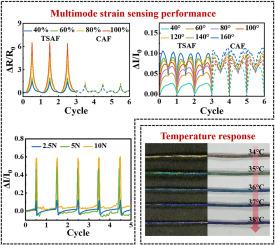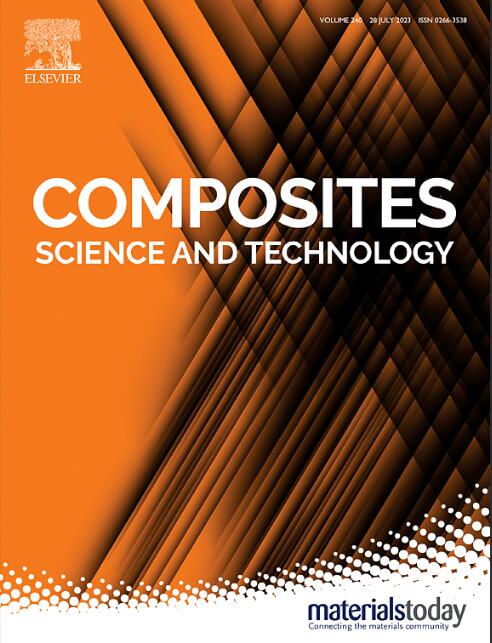Anti-interference flexible temperature-sensitive/strain-sensing aerogel fiber for cooperative monitoring of human body temperature and movement information
IF 8.3
1区 材料科学
Q1 MATERIALS SCIENCE, COMPOSITES
引用次数: 0
Abstract
In recent years, multi-functional flexible sensing fibers capable of detecting various physical and chemical stimuli capabilities have made significant advancements. However, the cross-sensitivity of the sensing materials to other stimuli can considerably reduce their sensitivity and accuracy of these multifunctional fibers. In this study, we initially fabricated a blending type (BAF) and a core-sheath type (CAF) strain-sensing aerogel fiber using an optimized one-step wet spinning process. Then, we coated the aerogel fiber with cholesteric liquid crystal as the middle layer and waterborne polyurethane as the outer layer to obtain a temperature-sensitive/strain-sensing aerogel fiber (TSAF). TSAF demonstrates distinct multi-model strain sensing performance, enabling the detection of tensile strains (0.1–111.5 %), bending strains (40°–160°), and compression strains. Moreover, within the ultra-narrow temperature range of 34 °C–38 °C, TSAF undergoes reversible color transformations from yellow-green-blue-purple, against both bright and dark backgrounds. This unique feature offered high sensitivity, rapid response time, and diverse color variations. By integrating fibers into clothing, a collaborative sensing system can be established to simultaneously monitor human physiology and movement information. These advancements hold significant potential for applications in smart clothing, medical care, and other fields.

用于协同监测人体温度和运动信息的抗干扰柔性温敏/应变传感气凝胶纤维
近年来,能够检测各种物理和化学刺激的多功能柔性传感纤维取得了重大进展。然而,传感材料对其他刺激的交叉敏感性会大大降低这些多功能纤维的灵敏度和准确性。在本研究中,我们采用优化的一步湿法纺丝工艺,初步制备了一种混合型(BAF)和一种芯鞘型(CAF)应变传感气凝胶纤维。然后,我们在气凝胶纤维的中间层涂覆了胆甾液晶,在外层涂覆了水性聚氨酯,从而获得了温敏/应变传感气凝胶纤维(TSAF)。TSAF 具有独特的多模式应变传感性能,可检测拉伸应变(0.1-111.5 %)、弯曲应变(40°-160°)和压缩应变。此外,在 34 ℃-38 ℃ 的超窄温度范围内,TSAF 可在明亮和昏暗的背景下发生黄绿-蓝紫色的可逆颜色转换。这一独特功能具有灵敏度高、响应速度快和色彩变化多样等特点。通过将纤维集成到服装中,可以建立一个协同传感系统,同时监测人体生理和运动信息。这些进步为智能服装、医疗保健和其他领域的应用带来了巨大潜力。
本文章由计算机程序翻译,如有差异,请以英文原文为准。
求助全文
约1分钟内获得全文
求助全文
来源期刊

Composites Science and Technology
工程技术-材料科学:复合
CiteScore
16.20
自引率
9.90%
发文量
611
审稿时长
33 days
期刊介绍:
Composites Science and Technology publishes refereed original articles on the fundamental and applied science of engineering composites. The focus of this journal is on polymeric matrix composites with reinforcements/fillers ranging from nano- to macro-scale. CSTE encourages manuscripts reporting unique, innovative contributions to the physics, chemistry, materials science and applied mechanics aspects of advanced composites.
Besides traditional fiber reinforced composites, novel composites with significant potential for engineering applications are encouraged.
 求助内容:
求助内容: 应助结果提醒方式:
应助结果提醒方式:


